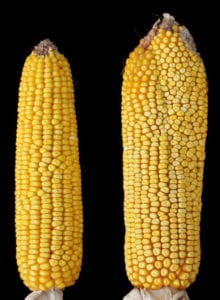By Daniel Dunaief
If we get a text message that our son just gained admission to his first choice for college, we might throw our arms in the air, pick up the phone and call him, or stand on the top of our desk and shout our joy to the room. We might feel, in that instant, as if he can achieve anything and, as a result, so can we.
While plants don’t send and receive text messages, they process and react to a range of signals, some of which can determine how and when they grow, which can be key parts of determining how much food they produce.
Recently, David Jackson, a professor at Cold Spring Harbor Laboratory, explored a mutation that causes corn, or maize, to experience growth that is so out-of-control that the corn becomes a disorganized mess. Jackson wondered what caused this growth and disrupted the creation of succulent rows of juicy, yellow bits ready to explode off the cob.
Stem cells can grow to become any type of cell. In this pathway, which was disrupted in the mutant and caused the uncontrolled growth, Jackson showed that the signal came from the leaves, which is likely responding to its surroundings. He discovered that fine tuning that mutation — or weakening the “grow-out-of-control” signal — was enough to cause a regular ear of corn to include as much as 50 percent more food. “What was surprising about our work is that we found this new stem cell pathway that had not been discovered in Arabidopsis,” which is, as Jackson described, considered the equivalent of the well-studied fruit fly in the plant world. “We had gone on to show that it was also present in Arabidopsis.”
At this point, he’s hoping to introduce these mutations or alleles into breeding lines to try to generate a similar increase in yields that he’s seen in the lab. He’s collaborating with DuPont Pioneer on that testing. “As in all areas of science, we make a basic discovery and hope it’ll be applicable,” he said. “We can’t guarantee it’ll work until” it’s checked in the field. “People cure cancer in mice, but find it’s more complicated in people. We’re hoping cumulative knowledge will lead to breakthroughs,” he added.
Sarah Hake, the director of the USDA Plant Gene Expression Center at the University of California at Berkeley, described the work as “important.” In an email, she suggested that “translation to more corn yield can take time, but this information will be crucial for thinking about breeding.”
Jackson received the mutated maize from a breeder in Russia. He then altered a wild type, or normal plant, to cause a similar mutation that produced more food. Jackson is excited about the potential to use the gene-altering technique called CRISPR, in which researchers can edit a genome, changing one or multiple base pairs at a time.

Jackson is not adding new genes but, rather, is “tweaking” the ones that are already there. He said agricultural companies can use CRISPR instead of dumping in a foreign DNA. In past experiments, Jackson has worked to produce a greater number of seeds in his experimental plants. In that work, however, he increased the number of seeds, although the size of the seeds was smaller, so the overall yield didn’t increase. In this study, however, he and his postdoctoral student Byoung Il Je produced more seeds that generated greater yield. The gene involved in this signaling pathway is called Fea3. It is part of the signaling network that tells the plant to pump more into the ear of the corn to produce more yield. Jackson named the gene Fea because of the way the corn looked. Fea stands for fasciated ear. He and the members of his lab had already characterized another gene, called Fea2.
Jackson has been working on this gene for 20 years, although the intensive work occurred more in the last four or five years. He said he’s benefited from the ability to take a mutant and identify the gene. When he started out 25 years ago, a graduate student could take five years to characterize a mutation and find a gene. “It was like looking for a needle in a haystack,” he said. Now, genome sequencing and fast mapping enables researchers to find a gene in as little as a few months. When he first produced the weaker mutation, Jackson wasn’t anticipating a higher yield but, rather, was hoping to prove that this gene was the one responsible for this uncontrolled growth that created a pulpy mess of corn. Jackson said he is “excited about the stem cell pathway” his lab discovered. He hopes this finding can lead to a better understanding of the signals that determine how a plant uses its resources.
A resident of Brooklyn, Jackson lives with his wife Kiyomi Tanigawa, an interior designer, and their eight-year-old son Toma.
Jackson, whose lab has seven postdoctoral researchers and one lab manager, plans to start experiments on tomatoes and rice to see how this gene is involved in similar signals in other food crops. He is also working on similar mutations to other genes like Fea3, which also might affect a plant’s decision to produce more food.





